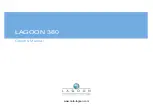
12
Over time, sunlight adversely affects the rubber coating
of the boat; therefore, it is advisable to store the boat in
shade each time after use.
CAUTION
•
On large surfaces of water (seas, lakes) pay attention
to water currents and off-shore breezes. Currents and
breezes may make it impossible to return to shore.
•
The in
fl
atable boat should not be used in challen-
ging conditions, such as in reduced visibility (night,
fog, rain).
•
It is necessary to suf
fi
ciently practise abandoning
an overturned boat on calm waters in advance.
Speci
fi
cations of the WW 2 dif
fi
culty grade - moderately
dif
fi
cult:
•
Irregular waves and rif
fl
es, medium rapids, small whirls and
eddies, low vertical drops, small rapids in watercourse with
heavy meandering or poor visibility
•
Regular
fl
ow and low, regular waves, small rapids, simple
obstacles, frequent meanders and fast current of water.
Subjective requirements for WW 2 white-water kayaking:
•
Knowledge of all basic forward and backward strokes, stee-
ring and command of the boat. Ability to evaluate the dif
fi
culty
of the stream and level height. Knowledge of simple re-
scue. Physical
fi
tness for longer trips, swimming.
Technical equipment for WW 2:
•
Agile, open boats (slalom types), boats with decking are more
suitable; a life jacket with a minimum displacement of 7.5 kg
ATTENTION
Pay great attention to your choice of
fl
otation life-jacket.
The
fl
otation life-jacket should have a tag bearing details
of its
fl
otation capabilities and safety certi
fi
cation.
5. Storage of the Boat – See Fig. 3
Remove the seats and transom prior to roll-up. Place all small
accessories to the small mesh bag. No sharp object may re-
main in the boat. Clean and dry the boat. Bleed air from all
chambers. The de
fl
ation may be sped up by rolling the boat
towards the valves. Once all air has bled, place the boat on an
even surface and roll up – refer to Fig. 3.
Lay the boat
fl
at. Fold both side tubes lengthwise so they do
not project outside the contour of the bottom. Now roll the boat
from both ends to the center. Place the folded halves on top
of each other and tie with the compressing strap. Insert the
boat in the transport bag, add the seats, transom and small
accessories. Force the air out of the bag, roll the end of the
bag and tie it with buckles.
6. Treatment and Storage
The rubber surface coating of the boat is sensitive to oils, gas-
oline, toluene, acetone, kerosene and similar thinning agents.
Prior to storing a dirty boat, wash it down with warm soapy
water. Rinse the boat with fresh water after using the boat in
seawater. It is recommended to check the state of the in
fl
ation
valves and the safety relief valves.
If a valve is not air-tight, it is possible to unscrew the valve
body from the boat with the use of a special valvekey and cle-
an its membrane with a strong jet of water or compressed air.
Prior to storage, it is recommended to rub the surface of the
boat with an agent intended for the treatment of such surfaces,
which has cleaning properties, and which impregnates the ma-
terial to prevent further dirtying, or which is capable of forming
a protective UV
fi
lter.
Never use agents containing silicon when treating your boat.
Store the clean and dry product in a dark dry place at a tem-
perature of (15 – 35) °C, at least 1.5 m from any radiant heat
source and out of the reach of rodents. During longterm sto-
rage, it is recommended to in
fl
ate the boat for 24 hours from
time to time to avoid fatiguing the fold lines.
It is also recommended to have the boat serviced by the ma-
nufacturer's authorized service station at least once every two
or three years.
Proper care and treatment of the boat will increase its service
life.
7. Guarantee Conditions
The guarantee period is 24 months and is calculated from the
date of sale.
The producer provides cost-free repairs or replacement of
faulty components for material faults or production faults.
8. Boat Repairs
You can easily repair a damaged boat yourselves by means of
the accompanying gluing set.
Gluing:
•
mark out the damaged area on the boat and choose an
appropriately sized patch;
•
the surfaces of both patch and place to be glued must be
clean, dry and without traces of old glue;
•
Degrease the patch and the damaged spot with acetone or
petrol;
•
spread a thin layer of glue on both surfaces to be glued and
repeat this step once the
fi
rst layer has dried;
•
after the second layer has dried, press the patch
fi
rmly on
the damaged place, weigh down or use a rolling pin on
a
fl
at surface.
For minor repairs (punctures), it is possible to re-in
fl
ate the
boat and continue using it after waiting for approx. 30 minutes;
after more serious repairs, you should wait for 24 hours before
using the repaired boat. Complicated repairs should be per-
formed by the manufacturer or at authorized service stations.
Guarantee repairs and post-guarantee repairs are provi-
ded by the manufacturer:
GUMOTEX, a. s.
Mládežnická 3062/3a
690 75 B
ř
eclav
Czech Republic
9. Product Disposal Method
The product should be disposed of at municipal waste dispo-
sal sites.
10. Packaging Disposal Method
Cardboard – recycle as the indicated symbol directs.
PE-LD plastic wrap (low-density branched polyethylene) – re-
cycle as the indicated symbol directs.
11. Type Parameters Tag
Each boat is provided with its own Type Parameters Tag which
displays the most important technical parameters.
Please follow these values. Above all, do not overload the boat
and maintain the recommended maximum pressures in the air
chambers.













































